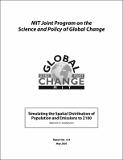Simulating the Spatial Distribution of Population and Emissions to 2100
Author(s)
Asadoorian, Malcolm O.
DownloadMITJPSPGC_Rpt123.pdf (1.003Mb)
Metadata
Show full item recordAbstract
Urbanization and economic development have important implications for many environmental processes including global climate change. Although there is evidence that urbanization depends endogenously on economic variables, long-term forecasts of the spatial distribution of population are often made exogenously and independent of economic conditions. A beta distribution for individual countries/regions is estimated to describe the geographical distribution of population using a 1° x 1° latitude-longitude global population data set. Cross-sectional country/regional data are then used to estimate an empirical relationship between parameters of the beta distribution and macroeconomic variables as they vary among countries/regions. This conditional beta distribution allows the simulation of a changing distribution of population, including the growth of urban areas, driven by economic forecasts until the year 2100.
Description
Abstract in HTML and technical report in PDF available on the Massachusetts Institute of Technology Joint Program on the Science and Policy of Global Change website (http://mit.edu/globalchange/www/).
Date issued
2005-05Publisher
MIT Joint Program on the Science and Policy of Global Change
Citation
Report no. 123
ISSN
http://mit.edu/globalchange/www/abstracts.html#a123
Series/Report no.
;Report no. 123
Keywords
population distribution, spatial econometric, urbanization